
ExxonMobil - Outlook for Energy 2019_watermark
.pdf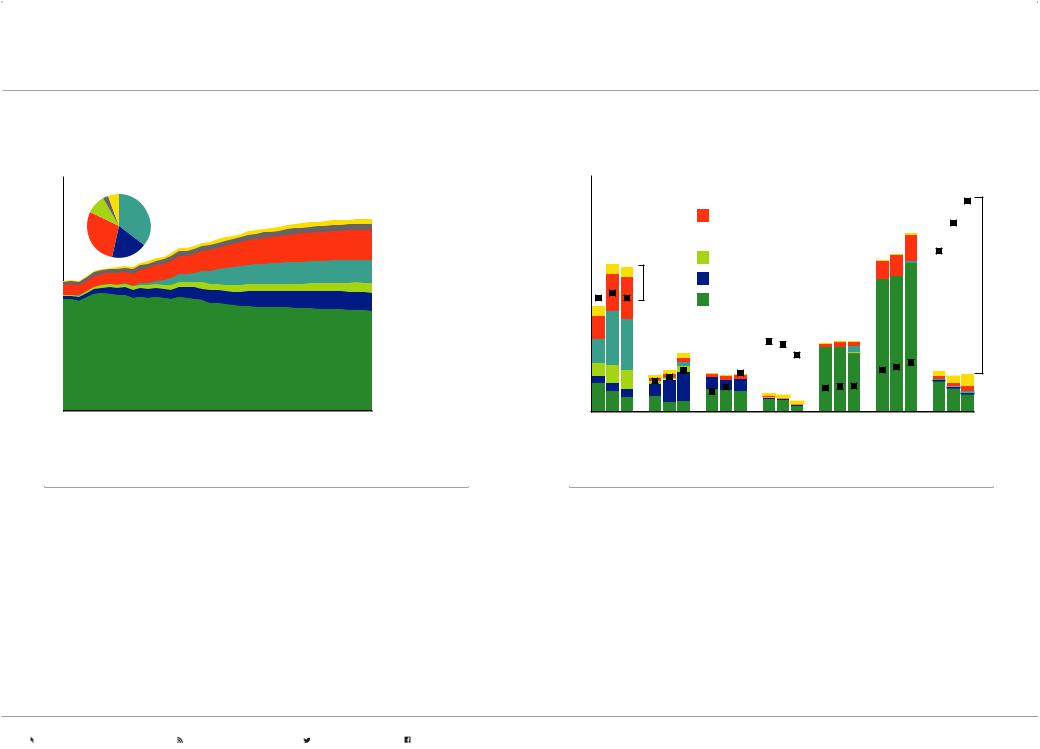
vk.com/id446425943 |
P.31 |
2019 OUTLOOK FOR ENERGY | SUPPLY |
|
|
|
LIQUIDS — PROJECTIONS
Liquids supply highlights the need for investment
Global liquids supply by type – MBDOE |
|
|
||
140 |
Growth '17-'40 |
|
|
|
120 |
|
|
|
Biofuels |
|
|
|
|
|
|
|
|
|
Other liquids |
100 |
|
|
|
Natural gas liquids (NGLs) |
80 |
|
|
|
Tight oil |
|
|
|
Oil sands |
|
|
|
|
|
|
60 |
|
|
|
Deepwater |
|
|
|
|
|
40 |
|
|
|
|
|
|
|
|
Conventional crude |
20 |
|
|
|
and condensate |
|
|
|
|
|
0 |
|
|
|
|
2000 |
2010 |
2020 |
2030 |
2040 |
Liquids supply highlights regional diversity
By region and type – MBDOE 50
 Other/Biofuels
Other/Biofuels
NGLs
40
 Tight oil
Tight oil
30 |
|
|
|
|
Oil sands |
|
|
|
|
|
|
|
Net |
Deepwater |
|
|
|
Net |
|
|
|
|
|
exports |
|
|
|
imports |
|
|
|
|
|
|
|
|
|
||
20 |
|
|
|
|
. DemandConventional crude and condensate |
|
|
||
10 |
|
|
|
|
|
|
|
|
|
0 |
'17 |
'25 |
'40 |
|
|
|
|
|
|
|
|
|
|
|
|
|
|
|
|
|
|
North |
Latin |
Africa |
Europe |
Russia/ |
Middle |
Asia |
|
|
America |
America |
|
|
Caspian |
East |
Pacific |
||
•The supply of existing oil production naturally declines at an estimated 7 percent per year without further investment. Significant investment is needed to offset this natural decline and meet the projected demand growth
•In 2017, conventional crude and condensate made up about two-thirds of the liquid supply. By 2040, new investment is expected to have diversified oil supply such that only about half of liquids will come from these conventional sources
•Tight oil is also rich in Natural Gas Liquids (NGLs), so tight oil growth brings significant new supplies of NGLs
•Biofuels grow more than 70 percent with increasing demand for lower-carbon liquid fuels and technology advancements that reduce costs and land-use
•North America tight oil and associated NGLs production nearly doubles between 2017 and 2025. This significant growth swings North America to a net exporter of liquids
•After 2025, new deepwater supplies from Latin America and conventional crude from the Middle East grow to meet global demand
•The Middle East and Russia/Caspian will continue to invest in conventional oil production to maintain their role as leading exporters, at about two-thirds of their production in 2040
•Asia Pacific remains the largest and fastest growing region for liquids demand, and relies on increasing imports to supply the strong demand
Visit exxonmobil.com/energyoutlook |
Subscribe to energyfactor.com |
Follow @exxonmobil |
Follow facebook.com/exxonmobil |
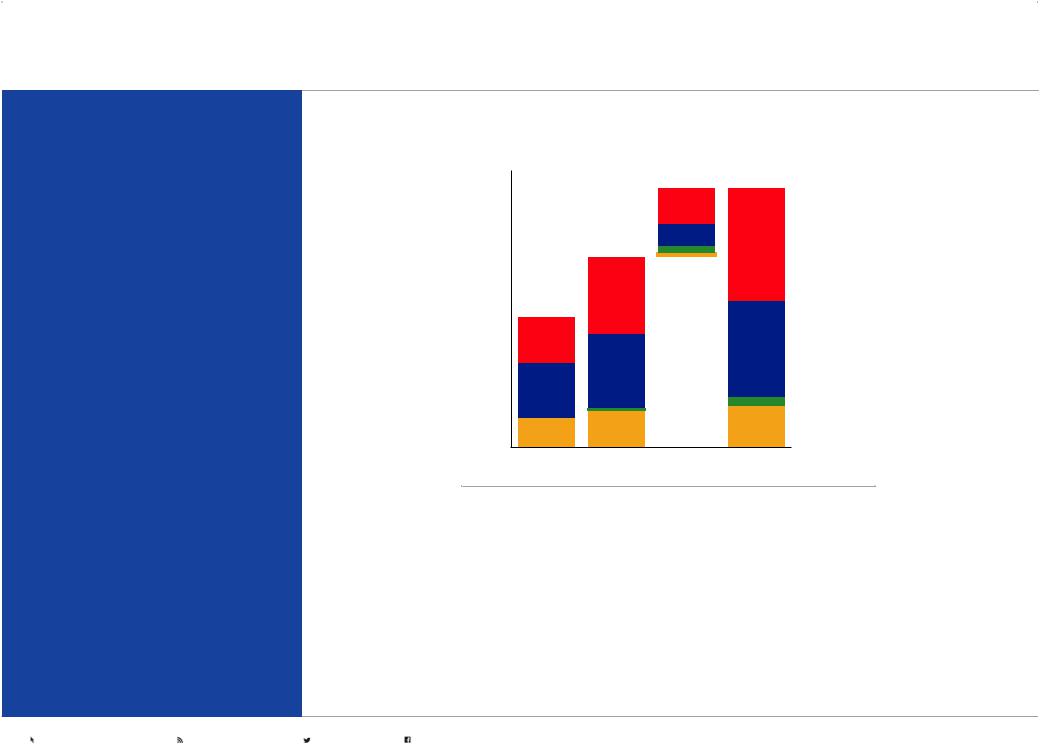
vk.com/id446425943 |
P.32 |
2019 OUTLOOK FOR ENERGY | SUPPLY |
|
|
|
NATURAL GAS — PROJECTIONS
Natural gas plays a vital role in satisfying the energy needs of consumers worldwide while helping to mitigate the risks of climate change.
Choosing natural gas as a cleaner-burning alternative to coal improves air quality and reduces carbon intensity.
Natural gas is abundant and versatile. It is a reliable and flexible fuel for electricity generation, a cleaner industrial fuel and convenient for home use. Natural gas grows more than any other energy source, rising from 23 percent of global energy supply in 2017 to 26 percent in 2040.
Natural gas resources are geographically and geologically diverse. North America’s unconventional gas resources are produced by applying horizontal drilling and hydraulic fracturing technologies. The Middle East and Africa are expected to tap large conventional natural gas resources. Natural gas production is expected to grow in every region
except Europe.
Natural gas trade is a critical link between resource-rich regions and demand centers in Asia Pacific and Europe. New liquefied natural gas export projects are expected to diversify the market and meet 40 percent of the growth in natural gas demand to 2040.
Reliable natural gas grows in every sector
World – BCFD
500
400
300
200
100
0
2000
2017 |
2040 |
Electricity generation
Industrial
Transportation
Residential / Commercial
•Natural gas is well-suited for homes, businesses and electric utilities seeking versatile, cleaner-burning energy
•Abundant and convenient, natural gas grows more than any other source of primary energy during the Outlook period
•Half of the growth in natural gas demand is for electricity generation and one-third is for industrial use
•Residential users rely on natural gas for heating and cooking
•Increased penetration of natural gas-fueled buses and trucks can help urban areas manage air quality
Visit exxonmobil.com/energyoutlook |
Subscribe to energyfactor.com |
Follow @exxonmobil |
Follow facebook.com/exxonmobil |
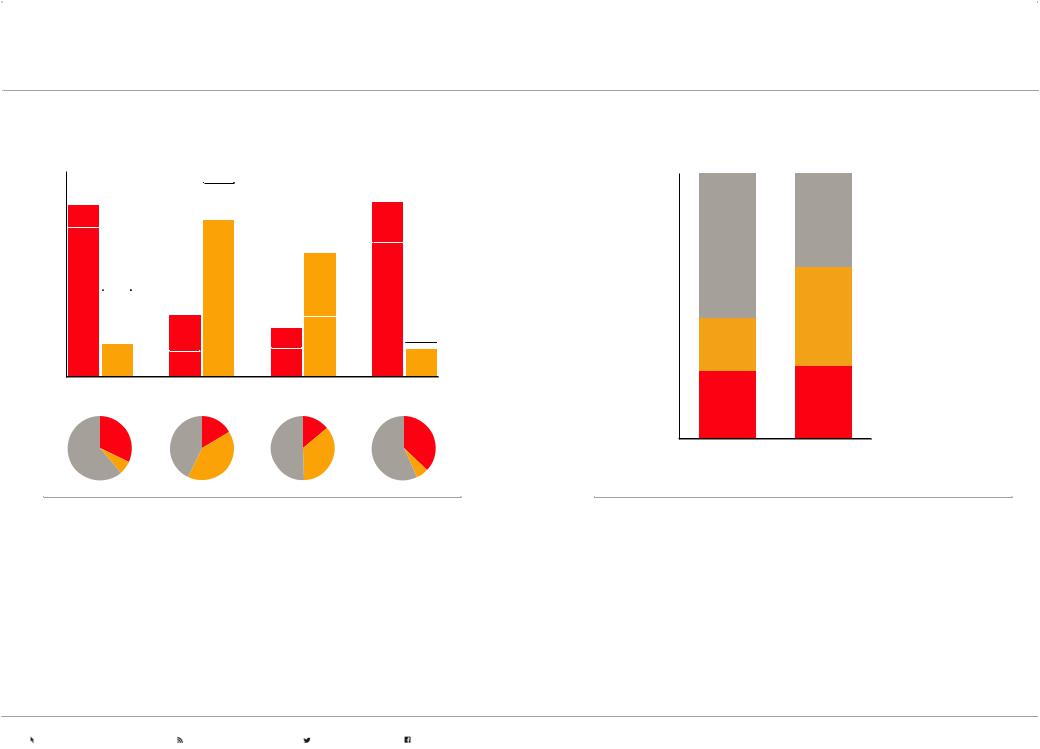
vk.com/id446425943 |
P.33 |
2019 OUTLOOK FOR ENERGY | SUPPLY |
|
|
|
NATURAL GAS — PROJECTIONS
Natural gas is growing, but coal is still predominant in non-OECD Asia
2040 - Quadrillion BTUs |
|
|
|
|||
80 |
|
|
|
|
|
|
60 |
2017 |
|
|
|
|
|
40 |
|
2017 |
|
|
|
|
|
|
|
|
|
||
20 |
|
|
|
|
|
|
0 |
Gas |
Coal |
|
|
|
|
OECD |
China |
Other AP |
Rest of |
|||
|
||||||
2040 - Share of primary energy |
|
non-OECD |
World |
|||
|
|
|
||||
Coal-to-natural gas switching reduces emissions
2040 - Global share |
|
100% |
|
80% |
Other |
|
|
60% |
|
|
Coal |
40% |
|
20% |
|
|
Natural gas |
0% |
|
Energy |
Energy-related |
Demand |
CO2 emissions |
•Natural gas rises in prominence as a cleaner burning alternative to coal over the Outlook period
•In China and Other AP non-OECD together, gas demand more than doubles from 2017 to 2040, but coal still plays a significant role in the region
•Coal demand doubles in Other AP non-OECD, partially offsetting major strides to reduce the use of coal in the OECD and China
•Outside of Asia Pacific, many developing countries are expected to leverage domestic natural gas supplies to meet rising electricity demand and fuel industrial growth
•In 2040, coal is expected to meet just 20 percent of global energy demand but produce more than 35 percent of energy-related CO2 emissions
•With the same boiler efficiency, burning natural gas to produce heat emits about 40 percent less CO2 than burning coal
•Choosing flexible, highly efficient gas-fired electricity generation to replace older, inefficient coal plants can reduce CO2 emissions by up to 60 percent while also producing fewer air pollutants
•Every 1 percent of global primary energy shifted from coal to natural gas can reduce energy-related CO2 emissions by nearly 1 percent in 2040
Visit exxonmobil.com/energyoutlook |
Subscribe to energyfactor.com |
Follow @exxonmobil |
Follow facebook.com/exxonmobil |
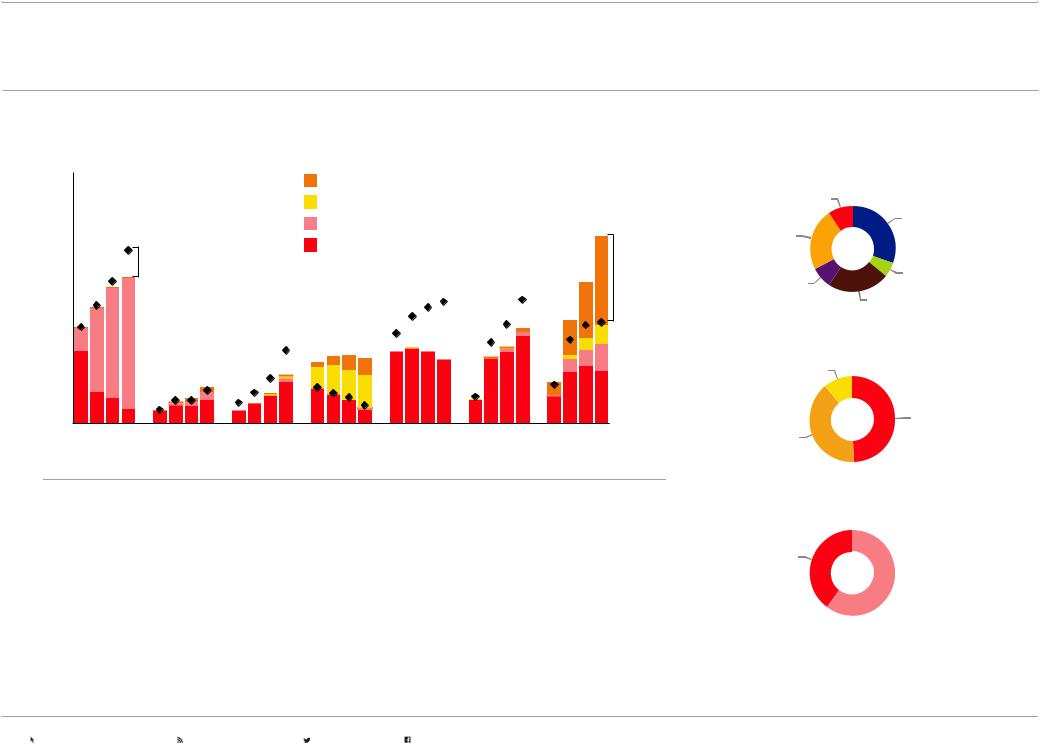
vk.com/id446425943 |
P.34 |
2019 OUTLOOK FOR ENERGY | SUPPLY |
|
02
NATURAL GAS — PROJECTIONS
Gas supply diversifies and trade grows to meet rising demand |
Share of supply growth 2017-2040 |
BCFD |
|
200 |
Production by region |
Liquefied natural gas (LNG) imports |
|
Pipeline imports |
Asia Pacific |
|
|
|
|
Local unconventional production |
|
|
|
North America |
|
150 |
|
|
|
Local conventional production |
|
|
|
Middle East |
|
|
|
|
. |
|
|
|
|
||
|
|
Net exports |
Total production |
|
|
|
Net |
Latin America |
|
|
|
|
|
|
|
|
|
||
|
|
|
|
|
|
|
|
imports |
|
|
|
|
|
|
|
|
|
Russia/Caspian |
|
|
|
|
|
|
|
|
|
|
|
100 |
|
|
|
|
|
|
|
|
Africa |
50 |
|
|
|
|
|
|
|
|
Supply type |
|
|
|
|
|
|
|
|
Pipeline |
|
|
|
|
|
|
|
|
|
|
|
'00 |
'17 '25 '40 |
|
|
|
|
|
|
|
Local production |
0 |
North |
Latin |
|
|
Russia/ |
Middle |
Asia |
|
|
|
Africa |
Europe |
|
LNG |
|||||
|
America |
America |
|
|
Caspian |
East |
Pacific |
|
|
• Rising global demand, competitive new projects in diverse locations and robust trade will shape future natural gas supplies
Resource type
• North America’s abundant unconventional gas is expected to feed new LNG projects and meet growing local demand
Conventional
• Africa’s natural gas production, demand and exports are poised to accelerate, led by Mozambique, Nigeria and Egypt
 Unconventional
Unconventional
• Russia/Caspian and the Middle East together are anticipated to retain more than half of inter-regional gas trade by further investing in export projects; both regions are well positioned to expand pipeline exports in addition to LNG trade
• Europe is likely to increasingly rely on natural gas trade to meet consumer demand as local production declines
• In 2017, Asia Pacific’s natural gas imports rivaled Europe’s; by 2025, the region’s total natural gas demand will likely surpass North America’s; and in 2040, LNG trade is expected to meet nearly half of Asia Pacific’s natural gas demand
Visit exxonmobil.com/energyoutlook |
Subscribe to energyfactor.com |
Follow @exxonmobil |
Follow facebook.com/exxonmobil |
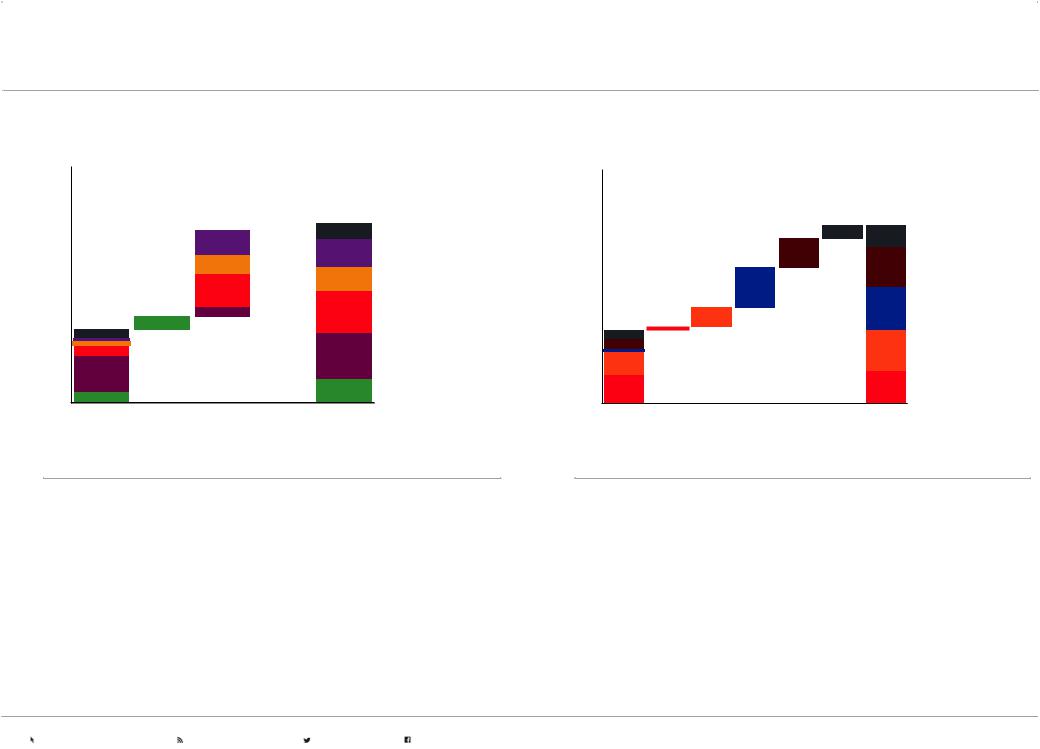
vk.com/id446425943 |
P.35 |
2019 OUTLOOK FOR ENERGY | SUPPLY |
|
|
|
NATURAL GAS — PROJECTIONS
Asia Pacific and Europe benefit from LNG imports
BCFD LNG Imports 120
100 |
Asia Pacific |
|
|
|
|
|
|
|
Growth |
|
Rest of World |
|
|
||
|
|
|
80 |
Other Asia Pacific |
|
|
60 |
India |
|
|
|
China |
40 |
|
|
Japan/Korea/Taiwan/ |
20 |
Singapore |
|
|
|
Europe |
0 |
|
2017 |
2040 |
Diverse natural gas supplies underpin new LNG exports
BCFD LNG Exports
120
100
80
60
40 |
|
20 |
|
0 |
|
2017 |
2040 |
Rest of World
Africa
North America
Middle East
Asia Pacific
•In 2017, LNG trade met about 10 percent of global natural gas demand; by 2040, LNG trade will meet nearly 20 percent of the world’s natural gas needs
•Asia Pacific absorbs about 80 percent of the growth in LNG from 2017 to 2040, helping the region to reduce its carbon intensity while sustaining economic growth and improving lives
•China’s ‘war on smog’ and ‘blue-sky’ policies have led to measurable improvements in urban air quality while boosting demand for LNG imports
•India and other Asia Pacific importers are expected to look to LNG to supplement domestic natural gas production, often leveraging existing natural gas infrastructure
•Europe is expected to tap competitive LNG to diversify its natural gas import portfolio
•In 2017, 85 percent of LNG exports originated in Asia Pacific, the Middle East or Africa
•North America’s LNG exports are projected to grow the most as low-cost unconventional gas production prompts investment
•East Africa, Qatar and Russia projects are expected to expand and diversify LNG exports
•The LNG market is expected to remain highly competitive due to abundant natural gas resources and many aspiring exporters
•The diversity and reliability of LNG supplies - combined with the flexibility to ship it where it is needed - make LNG a favorable choice for nations needing dependable, loweremissions energy sources to foster economic growth
Visit exxonmobil.com/energyoutlook |
Subscribe to energyfactor.com |
Follow @exxonmobil |
Follow facebook.com/exxonmobil |
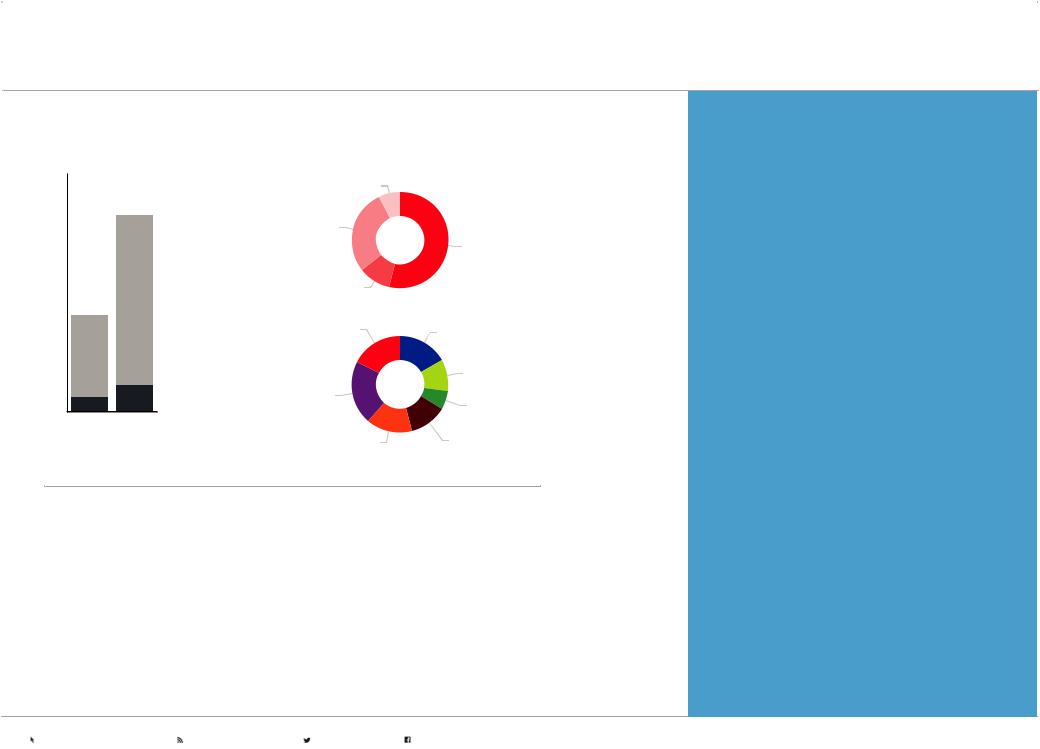
vk.com/id446425943 |
P.36 |
2019 OUTLOOK FOR ENERGY | SUPPLY |
|
|
|
NATURAL GAS — PROJECTIONS
Technology expands recoverable resources
World – thousand trillion cubic feet (TCF)
40 |
|
|
Remaining by type |
|
|
|
|
|
|
Coalbed methane |
|
30 |
|
Shale |
|
|
|
|
|
|
|
|
Conventional |
20 |
|
Tight |
|
|
|
|
|
|
Remaining resource |
Remaining by region |
|
|
|
||
|
|
Asia Pacific |
North America |
|
|
|
|
10
|
|
|
Latin America |
|
Cumulative production |
Russia/Caspian |
|
|
|
Europe |
|
0 |
|
|
|
|
|
|
|
2000 |
2017 |
|
|
|
|
Middle East |
Africa |
Source: IEA 2001 & 2018 World Energy Outlook |
|
|
|
•Natural gas resource estimates keep rising as technology unlocks resources previously considered too difficult or costly to produce
•Less than 15 percent of recoverable natural gas resources have been produced
•Remaining natural gas resources can provide about 200 years of supply at current demand
•About 45 percent of remaining natural gas resources are from unconventional sources like shale gas, tight gas and coalbed methane
•Natural gas resources are geographically widespread
Visit energyfactor.com to learn more about some of the latest advances in the field and the lab that are helping meet tomorrow’s energy needs.
Visit exxonmobil.com/energyoutlook |
Subscribe to energyfactor.com |
Follow @exxonmobil |
Follow facebook.com/exxonmobil |

vk.com/id446425943
EMISSIONS
Providing reliable, affordable energy to support prosperity and enhance living standards is coupled with the need
to do so in ways that reduce impacts on the environment, including the risks of climate change. This is society’s dual challenge.
Billions of people need reliable, affordable energy every day, but their use of energy is contributing to CO2 emissions. Progress on society’s energy and climate objectives requires practical approaches and new technology solutions that enable human development and economic progress.
Governments bear a unique responsibility in this regard. A key challenge is to develop and implement policies that seek to address climate change risks in the most practical and cost-effective way. Policies that promote innovation can expand the available options society has for providing access to energy while reducing impacts on the environment. Additionally, policies that harness the flexibility of free markets and competition can quickly scale the best solutions for each sector within a country. Effective policy frameworks will be critical to reduce global GHG emissions and meet society’s need for reliable and affordable energy.
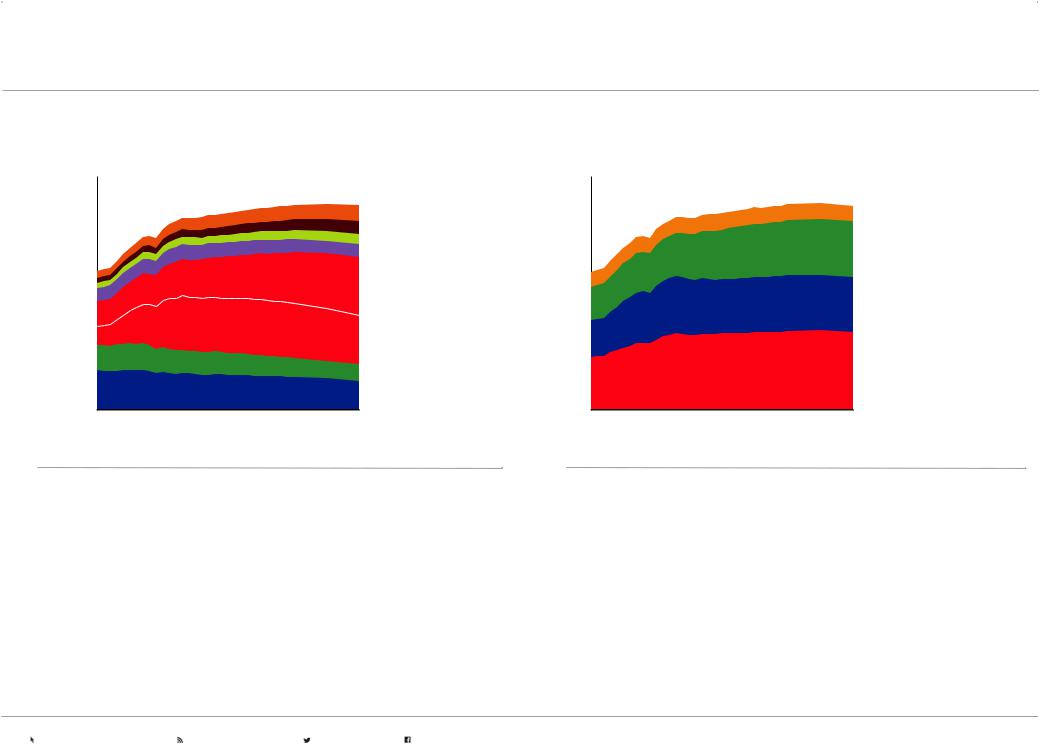
vk.com/id446425943 |
P.38 |
2019 OUTLOOK FOR ENERGY | EMISSIONS |
|
|
|
EMISSIONS — PROJECTIONS
Energy-related CO2 emissions peak
Billion tonnes |
|
|
|
|
40 |
|
|
|
|
|
|
|
|
Middle East |
30 |
|
|
|
Africa |
|
|
|
Latin America |
|
|
|
|
|
|
|
|
|
|
Russia/Caspian |
20 |
|
|
|
Other Asia Pacific |
|
|
|
|
|
10 |
|
|
|
China |
|
|
|
|
|
|
|
|
|
Europe |
0 |
|
|
|
North America |
|
|
|
|
|
2000 |
2010 |
2020 |
2030 |
2040 |
All sectors contributing to restrain CO2 emissions growth
Global energy-related CO2 emissions - billion tonnes |
|
|||
40 |
|
|
|
|
|
|
|
|
Residential/Commercial |
30 |
|
|
|
Transportation |
|
|
|
|
|
20 |
|
|
|
Industrial |
|
|
|
|
|
10 |
|
|
|
|
|
|
|
|
Electricity generation |
0 |
|
|
|
|
2000 |
2010 |
2020 |
2030 |
2040 |
•Policy choices, consumer preferences and technology play a role in balancing energy supply and demand and the impacts on emissions.
•From 2000 to 2017 the economic expansion in Asia Pacific saw CO2 emissions substantially rise, only partially offset by reductions in Europe and North America
•Global annual CO2 emissions are likely to peak by 2035, at some 5 percent above 2017 levels, as various countries try to reduce the emissions intensity of their economies
•This emission projection in the chart above tracks within the estimated range of emissions implied by the NDCs for 2030 as currently submitted by the countries as part of the Paris Agreement. However, these NDCs are not on a 2°C pathway as confirmed by the United Nations Environment Programme (UNEP) 2018 report. Further discussion on decarbonization is covered in the next section, “Pursuing a 2°C pathway”
•A shift to less carbon-intensive sources of electricity (e.g., renewables, nuclear and natural gas) will reduce the CO2 intensity of delivered electricity in 2040 by more than 35 percent compared to 2017
•Efficiency gains and growing use of less carbon-intensive energy will help reduce industrial CO2 emissions relative to GDP by about 50 percent over the Outlook period
•Transportation represents about 25 percent of CO2 emissions today, and this share is likely to grow modestly to 2040 driven by expanding commercial transportation activity
•Global light-duty vehicle CO2 emissions are expected to peak in the early 2020s before falling by more than 15 percent from that peak by 2040, as more efficient conventional vehicles and electric cars gain significant share
Visit exxonmobil.com/energyoutlook |
Subscribe to energyfactor.com |
Follow @exxonmobil |
Follow facebook.com/exxonmobil |
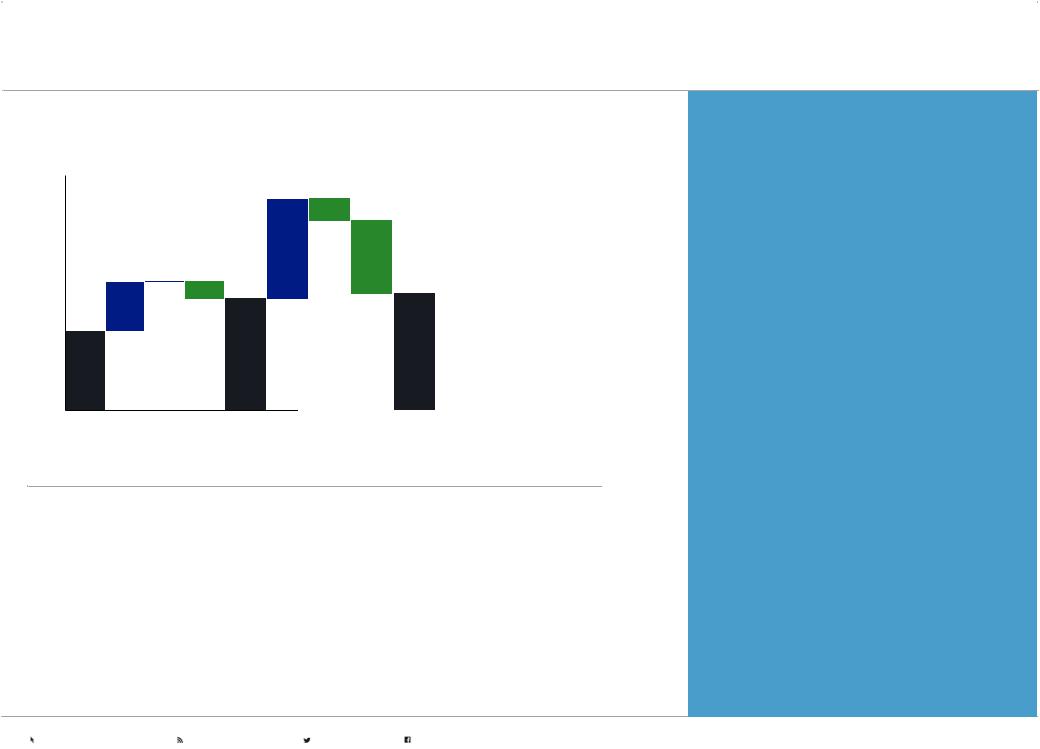
vk.com/id446425943 |
P.39 |
2019 OUTLOOK FOR ENERGY | EMISSIONS |
|
|
|
EMISSIONS — PROJECTIONS
Restraining global energy-related CO2 emissions
Billion tonnes |
70 |
60 |
50 |
40 |
30 |
20 |
10 |
0 |
2000 GDP |
CO2 |
Energy 2017 |
GDP |
CO2 |
Energy 2040 |
growth |
intensity |
efficiency |
growth |
intensity |
efficiency |
Want to learn more about energy-related CO2 emissions and ExxonMobil’s views?
Download our latest Energy & Carbon Summary at:
exxonmobil.com/news/ newsroom/publications- and-reports
•The primary driver of increasing global CO2 emissions between 2000 and 2017 was economic growth, as global GDP expanded about 60 percent
•Improving energy efficiency (energy use per unit of GDP) helped slow the growth in emissions, while global CO2 intensity of energy use remained fairly constant, with increased coal use in some non-OECD countries offsetting improvements in the OECD countries
•As the world’s economy nearly doubles by 2040, technology will be essential to mitigate emissions. Our Outlook projects a sustained improvement of CO2 intensity (more solar, wind, nuclear, coal to gas switch, CCS) in addition to accelerated efficiency gains (double the historic rate from 2000 to 2017)
•By 2040 efficiency and emissions intensity reduction are expected to contribute to a nearly 45 percent decline in the carbon intensity of the global economy
Visit exxonmobil.com/energyoutlook |
Subscribe to energyfactor.com |
Follow @exxonmobil |
Follow facebook.com/exxonmobil |

vk.com/id446425943
PURSUING A 2º C PATHWAY
Many uncertainties exist concerning the future of energy demand and supply, including potential actions that societies may take to address the risks of climate change. The following analysis is a supplement to the base Outlook and is intended to provide a perspective on hypothetical 2oC scenarios, highlighting the roles of new technologies, as well as oil and gas.
Since 1992, when nations around the world established the United Nations Framework Convention on Climate Change (UNFCCC), there has been an international effort to assess the risks of climate change.
After more than two decades of international effort, in December 2015, nations convened in Paris and drafted an agreement that for the first time signaled that both developed and developing nations will strive to undertake action on climate change and report on related progress.
The Paris Agreement1 “aims to strengthen the global response to the threat of climate change … by: Holding the increase in the global average temperature to well below 2°C above pre-industrial levels...”
Key elements of the agreement include:
•“Each party shall prepare, communicate and maintain successive nationally determined contributions that it intends to achieve.”
•“Each party shall communicate nationally determined contributions every five years.”
The nationally determined contributions (NDCs) provide important signals on government expectations related to the general direction and pace of likely policy initiatives to address climate change risks.4 In this regard, the United Nations Environment Programme (UNEP) reported in November 2018 that, “Pathways reflecting current NDCs imply global warming of about 3°C by 2100, with warming continuing afterwards.” Additionally,
the report states, “The majority [of G20 countries] are not yet on a path that will lead them to fulfilling their NDCs for 2030.”2 In other words, the current NDCs are insufficient to meet the aim of the Paris Agreement, and moreover, not all countries are yet on track with their current policies to meet their NDCs for 2030.
